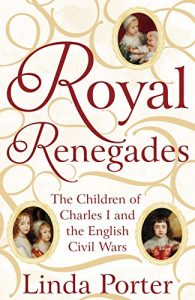Linda Porter is the author of ‘Mary Tudor: The First Queen’, ‘Katherine the Queen: The Remarkable Life of Katherine Parr’ and ‘Crown of Thistles: The Fatal Inheritance of Mary Queen of Scots.’
Linda’s new book, ‘Royal Renegades: The Children of Charles I and the English Civil Wars’ will be published in the UK on 6th October by Pan Macmillan.
To buy her new book in the UK:
Linda’s website: Linda Porter
Many thanks to Linda for answering my questions.
Why did you choose this subject for your book?
I chose it because it is a dramatic and little-known story that casts new light on the Civil Wars. This is one of the most important periods of our history but it is not as well-known as it should be. Fascination with the Tudors is all very well but it has rather cut us off from a more balanced understanding of our past. Most people don’t even know that Charles I had six surviving children when he was executed in 1649 and have no idea what happened to his family, with the possible exception of Charles II. The family was dispersed in 1642 when the Civil Wars broke out, with the future Charles II staying with his father, eventually joined by his brother James, before Charles was sent to France to join his mother as the royalist cause collapsed and James was abandoned by his father at Oxford when Charles I, miscalculating disastrously, handed himself over to the Scottish army at Newark. Mary had been packed off to the Netherlands as the child bride of the heir to the House of Orange, to endure a kind of exile (at least as she saw it) and an unhappy marriage. Elizabeth and Henry were left in London, effectively becoming hostages to Parliament, though they were well treated while under the guardianship of the earl of Northumberland, one of the peers who had opposed the king. The youngest child, born Princess Henrietta in Exeter in 1644, escaped to France with her redoubtable governess, to be brought up as a Catholic by her overbearing mother, at Louis XIV’s court. She eventually married the duke of Orleans, Louis XIV’s cross-dressing younger brother. It was a marriage made in hell.
What does your book add to existing works about the children of Charles I?
There are only two other books on the topic, both many years out of date. One, by Julia Dobson is for children and, though delightful in its way, has obvious limitations and the other, by Patrick Morragh, is more than 30 years old. Scholarship has obviously moved on a great deal since then.
Which child was the most difficult to write about?
I didn’t actually find any of them difficult to write about. The challenge was to give each one of the six his or her due, especially when concentration has tended to be on Charles II, whose period of exile between 1646 and 1660 has been romanticised, especially his escape after the battle of Worcester in 1651, when he had tried to regain his throne via his Scottish kingdom. There was nothing romantic about the attempts to hold on to his dignity, the grinding poverty and the tremendous condescension of the European courts which supported him at their expense. Perhaps the most difficult person to write about was their mother, the French princess, Henrietta Maria. I must admit to disliking Charles I’s wife. Whatever her virtues as a loyal wife, she was an appalling mother.
Which of the children did you find most interesting to write about?
I think Prince Henry, duke of Gloucester, Charles I’s youngest son. He was brought up with his sister, Elizabeth, in London, under the guardianship of Parliament. After Elizabeth’s death when they were on the Isle of Wight in 1650 he was entirely alone except for a devoted tutor and one or two servants. This bred in him a resilience and independence that dismayed his mother when they finally met again in 1653. Henry had been only one year old when she last saw him and she did not know him at all. Intelligent and affectionate, Henry longed to be, at last, a part of his family but his mother’s heavy-handed attempts to convert him to Catholicism and Henry’s brave resistance, encouraged by Charles II, who thought he would never regain his throne if his brother converted, caused a rift with Henrietta Maria that never healed. She dismissed Henry from her sight and never saw him again. He joined his brother James as a soldier of fortune fighting for the Spanish, returned with his two elder brothers when Charles II was restored in May, 1660 and died of smallpox just four months later. It is immensely sad.
What traits do you think they inherited from their parents, Charles I and Queen Henrietta Maria?
Charles II inherited his mother’s Bourbon looks but not his father’s intransigence. Mary and James were both more like their father, proud and unadaptable. Elizabeth and Henry were very much their own people, perhaps because of their isolation from the rest of the family. Elizabeth was highly intelligent (perhaps inherited from her grandfather, James VI and I) and little ‘Minette’ had some of the charm of her great-grandmother, Mary Queen of Scots. Both Charles and James became hopeless philanderers, of course, a weakness that is likely to have come from their French grandfather, Henri IV, rather than either of their parents.
You write that ‘historians remain divided about the role and influence of Henrietta Maria in the English Civil Wars.’ (p.362). How much influence do you think she had over the King?
On a personal level, Henrietta Maria had considerable influence over the king. After a very rocky start to their marriage, they were a devoted couple. But they disagreed on many aspects of policy and though she bombarded Charles I with advice he did not necessarily take it. Henrietta Maria became a scapegoat for all the perceived ills of the monarchy and her reputation was permanently tarnished by the propaganda of her enemies. She was both a Catholic and a foreigner and therefore doubly suspect. But she never really overcame her contempt for the English (she is the only queen consort in our history who refused to be crowned), and they returned her disdain with interest.
Why do you think that William Seymour (the grandson of Catherine Grey), who became governor to the Prince of Wales in 1641 has been depicted as an ‘elderly dimwit’? (p.65). Do you think he deserves that description?
William Seymour had had a difficult life before being briefly appointed governor to the Prince of Wales. He was something of an outsider and his secret marriage to Arbella Stuart, who, like him, had a distant claim to the throne, brought him the disfavour of James I. He fled abroad, leaving the hapless Arbella to die in the Tower in 1615. Elizabeth Fremantle has written a fine historical novel about Arbella – The Girl in the Glass Tower. This episode made him Seymour understandably wary of the court. Opinions on him have varied – Clarendon depicted him as the archetype of a country gentlemen, fond of his library and country pursuits; others have assumed he was viewed as a safe pair of hands by Parliament because he apparently did favour some sort of restriction on monarchical power, though he was certainly a supporter of the Crown.
My other interviews with Linda Porter:
Katherine the Queen: The Remarkable Life of Katherine Parr






































